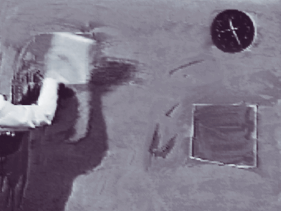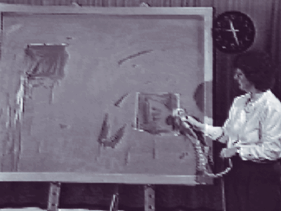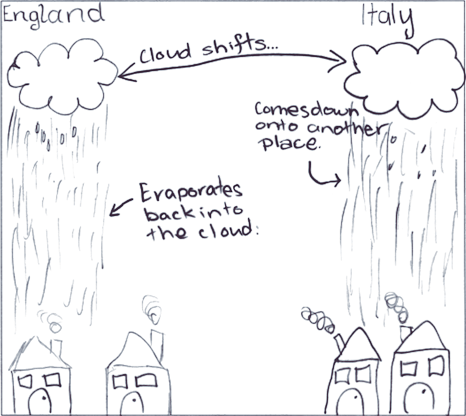| Approach: Station |
| Focus:
Explanation of evaporation
and understanding of the water cycle. |
 |
96k |
Resources: Video
showing evaporation with hand fanning and use of a hair dryer. |
Questions
/ instructions:
In this activity you are going
to watch a video clip showing
people cleaning a blackboard, then answer some questions about what you saw happening
in the video.
Watch the video and
then answer these questions.
You may replay the video if you need to. |
I tënei
mahi e mätakitaki ana koutou i tëtahi rïpene ataata poto o ngä
tängata e ükui ana i te papatuhituhi, kätahi ka whakautu i ngä
pätai o ngä mahi i kite koutou.
Mätakitaki
i te ataata, ä, ka whakautu i ënei pätai. Me whakaatu anö
te rïpene ataata mehemea koutou e hiahia ana. |
|
 |
Two squares were marked on the blackboard. One was dried using
fanning (left) one was dried using a hair dryer (right).
|
 |
|
| |
%
responses |
|
GEd |
MI |
1.
Why did fanning the wet blackboard help it to dry?
He aha i maroke ai te papatuhituhi i te täwhiritanga? |
0 |
0 |
| |
fanning moves moist air away from the blackboard to allow more to evaporate |
|
mentions
wind and/or water vapour and/or evaporation |
9 |
12 |
|
mentions
wind or air movement only |
63 |
79 |
2.
The hairdrier uses heat
as well as fanning. Why did the heat dry the blackboard faster?
He mahana, he täwhiri ngä whakamahinga o te whakamaroke
makawe. He aha i tere ake ai te maroke o te papatuhituhi i te mahana? |
50 |
34 |
| |
mentions
increased warmth helping evaporation |
3.
Where does the water go as the blackboard dries?
Ka tömiti te wai ki hea i te wä e maroke haere
ana te papatuhituhi? |
50 |
40 |
| |
evaporation
or equivalent (eg. "into the air") |
4.
Now think about a puddle on the footpath. Where does the water go when the puddle
dries out?
Nä, whakaaro ki tëtahi höpuapua i te ara hïkoi. Ka ngaro te
wai ki hea ina tömiti ai te höpuapua? |
9 |
2 |
| |
both
in to the air and the ground |
|
into
the air/sky |
46 |
40 |
|
into
the ground |
30 |
30 |
|
5. The water that falls
as rain in one place may come from another place that is far away. Explain
how this happens. You
can draw a diagram with labels to help explain your answer.
Tërä
pea ko te ua o tëtahi wähi i puta kë mai i tëtahi wähi
pämamao. Whakamäramatia
he aha i pënä ai?
Tängia he hoahoa, me öna tapa, hei whakamärama i tö whakautu. |
10 |
14 |
 |
Includes all three aspects: |
|
water
evaporation from source,
cloud movement,
rain falling elsewhere |
Commentary:
Overall, the performances of GEd (General Education) and MI (Mäori Immersion)
students were not statistically significantly different. |